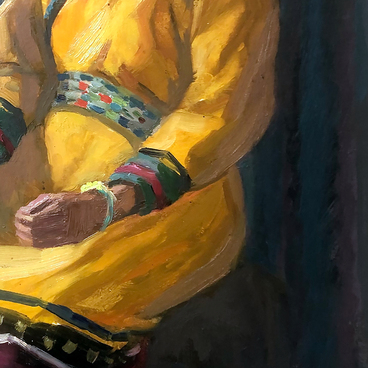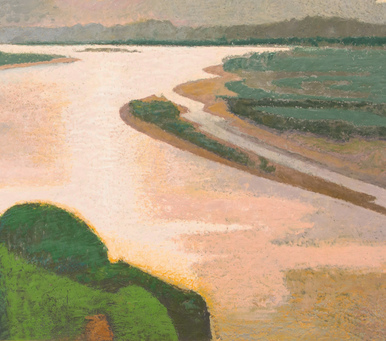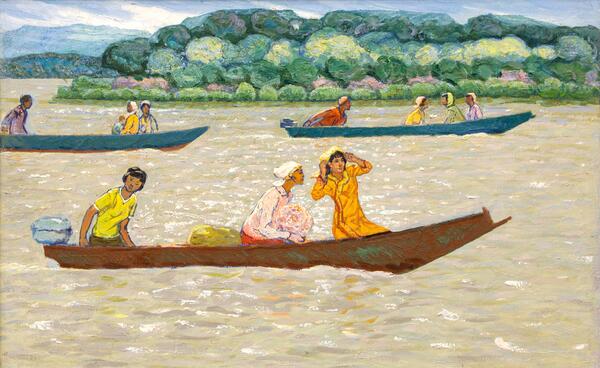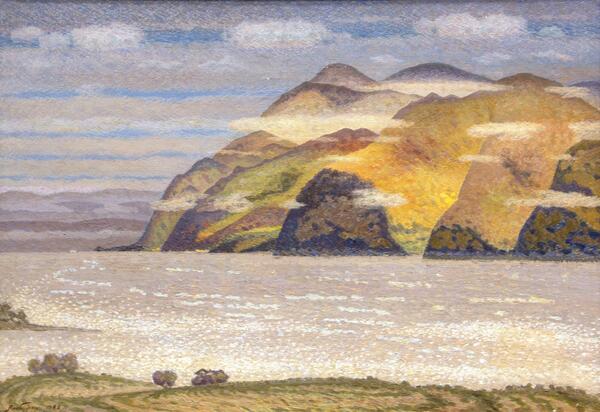The real name of the artist Georgy Lee Girsu in Korean is Jiren Lee. At the end of 1937, the Koreans began to be deported from the Russian Far East, and the artist’s family ended up in Samarkand, where there was a mix-up with the documents: his first and last names were combined into one surname, and he was named Georgy as it seemed similar to his real first name.
Life in the new surroundings was not easy, and Georgy-Jiren had to take a part-time job as a coal heaver in a club, pick up cotton and harvest sugar beets. However, his life was about to take an unexpected turn: during the war, the Ilya Repin Institute had to be relocated from Leningrad to Samarkand, so Lee Girsu joined the art department. After the evacuation, he and other fellow students went to Zvenigorod and then to Leningrad; in 1949, he became engaged in the reconstruction of the city and received a medal for his contribution.
Lee Girsu was one of the artists who accepted Georgy Tsivilyov’s invitation to create an art scene in Komsomolsk-on-Amur. The artist felt captivated by the nature of the Khabarovsk Krai, the dark waters of the Amur River, and the colorful embroidery of local robes — more than that, they reminded him of Samarkand, which he had to leave behind a long time ago.
The painting called “Waiting for the Steamboat” presents an intertwinement of the artist’s early memories and later experience of living near the Amur River. The background is painted with “vibrating” brushstrokes that create the impression of the “moving” air and are characteristic of the artist’s manner of painting. The faces of Nanai women sitting on travel bags near the rubbly bank are clearly outlined in contrast with the deliberately blurred landscape. The bright colors of their robes and the location of trim strips of contrasting colors indicate that the women are dressed for a special occasion. One of them has a traditional hairstyle with two braids; the other three women are wearing headscarves and have a puffy bun at the nape of their necks, which hints at the influence of Soviet fashion.
Honing his skills, Georgy Lee Girsu closely watched the work of the most prominent artists of his time: Pyotr Ivanovich Petrovichev, Leonard Viktorovich Turzhansky, Yefrem Ivanovich Zverkov, brothers Sergey and Alexey Petrovich Tkachev, as well as his student peers Andrey Andreyevich Mylnikov and Vyacheslav Frantsevich Zagonek. The artist’s style was clearly influenced by Impressionism and Pointillism.
Life in the new surroundings was not easy, and Georgy-Jiren had to take a part-time job as a coal heaver in a club, pick up cotton and harvest sugar beets. However, his life was about to take an unexpected turn: during the war, the Ilya Repin Institute had to be relocated from Leningrad to Samarkand, so Lee Girsu joined the art department. After the evacuation, he and other fellow students went to Zvenigorod and then to Leningrad; in 1949, he became engaged in the reconstruction of the city and received a medal for his contribution.
Lee Girsu was one of the artists who accepted Georgy Tsivilyov’s invitation to create an art scene in Komsomolsk-on-Amur. The artist felt captivated by the nature of the Khabarovsk Krai, the dark waters of the Amur River, and the colorful embroidery of local robes — more than that, they reminded him of Samarkand, which he had to leave behind a long time ago.
The painting called “Waiting for the Steamboat” presents an intertwinement of the artist’s early memories and later experience of living near the Amur River. The background is painted with “vibrating” brushstrokes that create the impression of the “moving” air and are characteristic of the artist’s manner of painting. The faces of Nanai women sitting on travel bags near the rubbly bank are clearly outlined in contrast with the deliberately blurred landscape. The bright colors of their robes and the location of trim strips of contrasting colors indicate that the women are dressed for a special occasion. One of them has a traditional hairstyle with two braids; the other three women are wearing headscarves and have a puffy bun at the nape of their necks, which hints at the influence of Soviet fashion.
Honing his skills, Georgy Lee Girsu closely watched the work of the most prominent artists of his time: Pyotr Ivanovich Petrovichev, Leonard Viktorovich Turzhansky, Yefrem Ivanovich Zverkov, brothers Sergey and Alexey Petrovich Tkachev, as well as his student peers Andrey Andreyevich Mylnikov and Vyacheslav Frantsevich Zagonek. The artist’s style was clearly influenced by Impressionism and Pointillism.




